Managing Diabetic Retinopathy – The Body and the Eyes

Diabetic Retinopathy is a common but serious complication of diabetes that affects the blood vessels in the retina, the light-sensitive tissue at the back of the eye. It is one of the leading causes of vision loss in adults, and its progression is closely linked to how well blood sugar levels and overall health are managed.
While treatments like laser therapy and injections can help control the eye-related effects, effective long-term management requires a broader approach. In other words, protecting your vision also means taking care of your whole body. In this article, we’ll explore how managing both systemic health and eye-specific issues is essential in controlling diabetic retinopathy.
Understanding Diabetic Retinopathy
Diabetic retinopathy develops when high blood sugar levels damage the tiny blood vessels in the retina. Over time, these vessels can leak fluid or bleed, distorting vision and potentially leading to blindness. There are two main stages:
- Non-proliferative diabetic retinopathy (NPDR): The early stage, where blood vessels weaken and may leak.
- Proliferative diabetic retinopathy (PDR): The advanced stage, where abnormal new vessels grow, increasing the risk of bleeding and retinal detachment.
Early stages may show no symptoms, which is why regular eye exams are crucial for anyone with diabetes.
Managing Your Blood Sugar: The Foundation of Control
The most important step in managing diabetic retinopathy is controlling your blood sugar levels. Persistent high glucose damages blood vessels throughout the body, including those in the eyes. Here’s what you can do:
- Monitor your blood sugar regularly. Use a glucose meter or continuous glucose monitor (CGM) to stay within your target range.
- Follow your treatment plan. Take insulin or other prescribed medications as directed.
- Be consistent with meals and physical activity. This helps avoid blood sugar spikes and crashes.
Studies have shown that good blood sugar control can significantly slow the progression of diabetic retinopathy, especially in its early stages.
Don’t Overlook Blood Pressure and Cholesterol
Managing your diabetes isn’t just about glucose, it’s also about your cardiovascular health. High blood pressure and elevated cholesterol levels can worsen eye damage. To protect your vision:
- Keep your blood pressure within a healthy range. Aim for around 130/80 mmHg, or as recommended by your doctor.
- Control your cholesterol levels. A balanced diet low in saturated fats and high in fibre can help.
- Take prescribed medications consistently. Drugs like ACE inhibitors or statins may also have protective benefits for your eyes.
By managing these factors, you reduce the strain on your blood vessels and slow the progression of retinopathy.
Eye-Specific Monitoring and Treatments
Although managing your overall health is crucial, direct eye care is also essential. Diabetic retinopathy can be treated more effectively when caught early. Here’s what to expect in terms of eye care:
- Annual dilated eye exams. These allow your eye specialist to detect early changes that you might not notice.
- OCT scans and retinal imaging. These diagnostic tools provide detailed views of the retina and help track disease progression.
Treatment options include:
- Laser therapy to seal leaking vessels.
- Anti-VEGF injections to reduce swelling and prevent abnormal vessel growth.
- Vitrectomy in advanced cases with retinal bleeding or detachment.
Following your ophthalmologist’s recommendations is key to maintaining your vision.
Nutrition and Lifestyle: Building a Healthy Routine
What you eat and how you live play an important role in both diabetes and eye health. A nutrient-rich diet and active lifestyle can improve circulation, lower inflammation, and support overall wellness. Consider these habits:
- Eat a balanced diet rich in leafy greens, whole grains, lean proteins, and healthy fats.
- Include eye-friendly nutrients like omega-3s, lutein, and vitamin C.
- Exercise regularly. Even 30 minutes of moderate activity five days a week can improve insulin sensitivity.
- Quit smoking. Tobacco use significantly increases the risk of diabetic complications, including retinopathy.
Small, consistent changes can make a big impact on your long-term health.
Emotional and Mental Well-Being
Managing a chronic condition like diabetes can be mentally taxing. Stress not only affects blood sugar but can also lead to poor self-care habits. Here are a few strategies to maintain mental balance:
- Join a support group or talk to others living with diabetic complications.
- Practice stress-reducing activities like yoga, meditation, or walking.
- Seek professional support if you feel overwhelmed, anxious, or depressed.
Taking care of your mental health is part of managing the whole picture, including your eyes.
Conclusion
Diabetic retinopathy is not just an eye condition, it’s a reflection of how well your diabetes is being managed across the board. By focusing on both eye care and systemic health, you can slow the progression, preserve your vision, and improve your overall quality of life. Whether you’re newly diagnosed or managing long-term diabetes, remember: your daily choices matter. With the right care, support, and education, you can take control of diabetic retinopathy and protect your sight for years to come.









